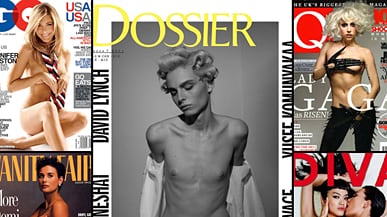This week, Barnes & Noble and Borders censored the cover of a magazine that showed model Andrej Pejic without a shirt. Isabel Wilkinson on what this means for gender-bending, female portrayals in the media—and why we should care. Plus, Pejic reveals he's filming a porn movie.
UPDATE: Borders continued to deny its involvement in the incident on Friday, telling The Daily Beast that "at no time did Borders request opaque polybags for this issue of Dossier Magazine."
Andrej Pejic is the model with long blond hair, hips as slim as Kate Moss', and cheekbones as pronounced as Cindy Crawford's. But there's one slight difference: He's a 19-year-old Serbian boy. Pejic has risen to new heights this year, walking runways from Jean-Paul Gaultier to Raf Simons to Richard Chai. He's appeared in countless editorial spreads in both men's and women's clothing, including in French and Italian Vogue. He's also the face Marc Jacobs' Spring 2011 ad campaign.
But this week, Dossier Journal, on which Pejic appears shirtless, was censored at both Barnes & Noble and Borders bookstores across America. Barnes & Noble, which initially insisted that the magazine be put in an opaque "poly bag," explained its decision to Dossier's distributor: "The picture can be misinterpreted as a girl as the model is young and it could be deemed as a naked female." The move incited outcry on the blogosphere--less than a week after pictures of another shirtless man on a magazine cover, Congressman Aaron Schock, spread like wildfire. "If Andrej had a more masculine face, would this be an issue?" asked one writer at Styleite.com.
Censoring Andrej Pejic marks the first major backlash against the category-defying model this year. But the move raises larger questions about how far gender ambiguity has really come—and how much people are really willing to take. It has been a good year for the transgender movement. Lady Gaga has celebrated being "born this way;" Chaz Bono's gender-reassignment surgery became the subject of a well-received documentary; James Franco has cross-dressed (on more than one occasion); and Lea T., Riccardo Tisci's transgender assistant at Givenchy, has become a fashion icon. The New York Times called 2010 the "year of the transsexual." "It's great to see this "trans moment" happening, because people that identify as trans have not always been included," says Juliet Williams, a professor of women's studies at UCLA.
But a rise in the visibility of transgendered people in the media has not yet translated into the mainstream. "It is naïve to assume that the jump in any kind of embrace of transgender imagery crosses over automatically to a large-market bookseller," says Dennis Freedman, the creative director at Barneys who previously held the same post at W magazine. "To be honest, it's not so surprising that this kind of thing happens. For this to cause controversy at Barnes & Noble is understandable."
Gallery: 10 Banned Magazine Covers

The debate is, at its core, about a fundamental difference between perception and reality. By American standards, if a boy is a boy, then he can be shirtless on a magazine cover. If a girl is a girl, then she can't. But if a boy looks like a girl, then what? "There's this expectation that men are masculine, and that women are feminine, and have bodies that can be recognized as female," says Paisley Currah, a professor of political science at Brooklyn College and the author of the upcoming book United States of Gender. "So Andrej, who is being presented socially as a woman, but whose body is a man, upsets those expectations. And he raises everyone's anxieties about gender as a result." As Williams puts it: "Andrej is taking the body back by asking, 'Who gets to say what makes us male and what makes us female?' And that is what's disturbing to the powers that be."
And for Pejic's part, the last thing he'll ever do is stop pushing the envelope. "I have just been named the 98th sexiest woman in the world," he says triumphantly, referring to a recent ranking by FHM.
Pejic sees himself as decidedly post-gender. He said he identifies simultaneously with both males and females, and, as a result, is defined by neither. He wears both women's and men's clothes in his free time, but says he's "not so concerned with looking very sexy," and cares more about "the art of dressing." For him, the controversy transcends gender entirely. "I think the gender of the topless person on the cover is irrelevant, the question we should pose is whether this is porn or art," he said in an email to The Daily Beast.
If that's the case, then the Barnes & Noble and Borders debacle isn't just a question of censoring the transgender body. It is also about censoring the female body—which is what Pejic appears to be on the cover of Dossier. "I would like to think [this issue] has nothing to do with transgender," says Freedman. "It's about the perception of showing... it's the nipple of a very young girl. If anything, it's about pedophilia." To that end, this instance is forcing a discussion, too, of how female nudity is approached in the U.S. "This is about censorship of a trans body, but it's also about censoring the bodies that are naturally female," Williams says. "Andrej may become a trans hero—but also a feminist hero. He's getting people to think of ordinary forms of censorship."
Gallery: Andrej Pejic

It's unclear whether the Pejic cover will change the way the female or transgendered body is depicted on American magazines. But since the issue exploded in the press this week, Barnes & Noble has changed its position on the subject. According to Dossier's publisher, the bookseller called on Thursday for the magazine to be removed from the opaque polybag—effectively lifting the censor. (Borders, meanwhile, maintains that it never wanted to censor the image in the first place—and has taken steps to have stories on this subject removed from blogs, such as the initial post about it on Elle.com. On Friday morning, a spokesperson from the retailer said that "at no time did Borders request opaque polybags for this issue of Dossier Magazine."
Dossier, with a circulation of only 20,000, has enjoyed a spike in traffic—with four times the usual number of visitors to its website in the past week.
And for Pejic's part, the last thing he'll ever do is stop pushing the envelope. "I have just been named the 98th sexiest woman in the world," he says triumphantly, referring to a recent ranking by FHM. Pejic has said that he wants to pose for Playboy, and now informs The Daily Beast of his next project: "I'm filming a porn movie."
Isabel Wilkinson is a fashion and arts correspondent for The Daily Beast.





